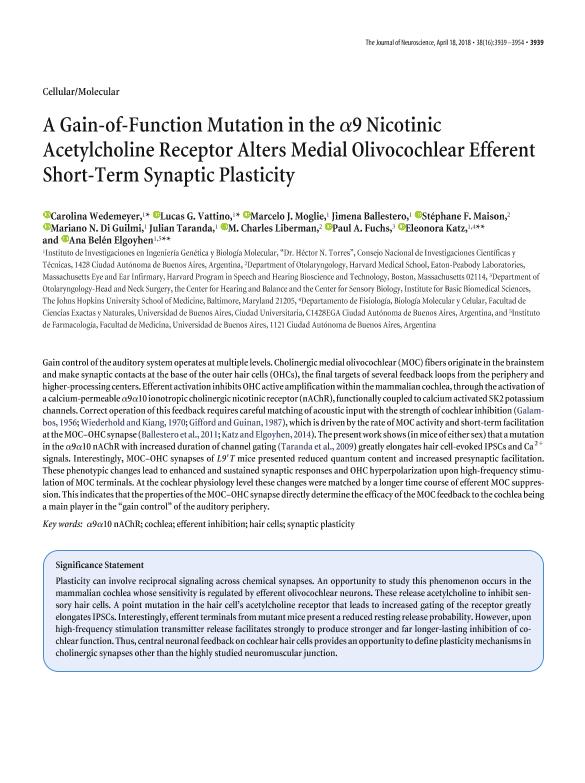Artículo
A gain-of-function mutation in the α9 nicotinic acetylcholine receptor alters medial olivocochlear efferent short-term synaptic plasticity
Wedemeyer, Carolina ; Vattino, Lucas Gabriel
; Vattino, Lucas Gabriel ; Moglie, Marcelo Javier
; Moglie, Marcelo Javier ; Ballestero, Jimena Andrea
; Ballestero, Jimena Andrea ; Maison, Stéphane F.; Di Guilmi, Mariano Nicolás
; Maison, Stéphane F.; Di Guilmi, Mariano Nicolás ; Taranda, Julian
; Taranda, Julian ; Liberman, M. Charles; Fuchs, Paul A.; Katz, Eleonora
; Liberman, M. Charles; Fuchs, Paul A.; Katz, Eleonora ; Elgoyhen, Ana Belen
; Elgoyhen, Ana Belen
 ; Vattino, Lucas Gabriel
; Vattino, Lucas Gabriel ; Moglie, Marcelo Javier
; Moglie, Marcelo Javier ; Ballestero, Jimena Andrea
; Ballestero, Jimena Andrea ; Maison, Stéphane F.; Di Guilmi, Mariano Nicolás
; Maison, Stéphane F.; Di Guilmi, Mariano Nicolás ; Taranda, Julian
; Taranda, Julian ; Liberman, M. Charles; Fuchs, Paul A.; Katz, Eleonora
; Liberman, M. Charles; Fuchs, Paul A.; Katz, Eleonora ; Elgoyhen, Ana Belen
; Elgoyhen, Ana Belen
Fecha de publicación:
04/2018
Editorial:
Society for Neuroscience
Revista:
Journal of Neuroscience
ISSN:
0270-6474
Idioma:
Inglés
Tipo de recurso:
Artículo publicado
Clasificación temática:
Resumen
Gain control of the auditory system operates at multiple levels. Cholinergic medial olivocochlear (MOC) fibers originate in the brainstem and make synaptic contacts at the base of the outer hair cells (OHCs), the final targets of several feedback loops from the periphery and higher-processing centers. Efferent activation inhibitsOHCactive amplification within the mammalian cochlea, through the activation of a calcium-permeable α 9 α 10 ionotropic cholinergic nicotinic receptor (nAChR), functionally coupled to calcium activated SK2 potassium channels. Correct operation of this feedback requires careful matching of acoustic input with the strength of cochlear inhibition (Galambos, 1956; Wiederhold and Kiang, 1970; Gifford and Guinan, 1987), which is driven by the rate of MOCactivity and short-term facilitation at theMOC-OHCsynapse (Ballestero et al., 2011; Katz and Elgoyhen, 2014). The present work shows (in mice of either sex) that a mutation in the α 9α 10 nAChR with increased duration of channel gating (Taranda et al., 2009) greatly elongates hair cell-evoked IPSCs and Ca2+signals. Interestingly, MOC–OHC synapses of L9’T mice presented reduced quantum content and increased presynaptic facilitation. These phenotypic changes lead to enhanced and sustained synaptic responses and OHC hyperpolarization upon high-frequency stimulation of MOC terminals. At the cochlear physiology level these changes were matched by a longer time course of efferent MOC suppression. This indicates that the properties of theMOC-OHCsynapse directly determine the efficacy of the MOCfeedback to the cochlea being a main player in the “gain control” of the auditory periphery.
Palabras clave:
Cochlea
,
Efferent Inhibition
,
Hair Cells
,
Synaptic Plasticity
,
Α9α10 Nachr
Archivos asociados
Licencia
Identificadores
Colecciones
Articulos(INGEBI)
Articulos de INST.DE INVEST.EN ING.GENETICA Y BIOL.MOLECULAR "DR. HECTOR N TORRES"
Articulos de INST.DE INVEST.EN ING.GENETICA Y BIOL.MOLECULAR "DR. HECTOR N TORRES"
Citación
Wedemeyer, Carolina; Vattino, Lucas Gabriel; Moglie, Marcelo Javier; Ballestero, Jimena Andrea; Maison, Stéphane F.; et al.; A gain-of-function mutation in the α9 nicotinic acetylcholine receptor alters medial olivocochlear efferent short-term synaptic plasticity; Society for Neuroscience; Journal of Neuroscience; 38; 16; 4-2018; 3939-3954
Compartir
Altmétricas



